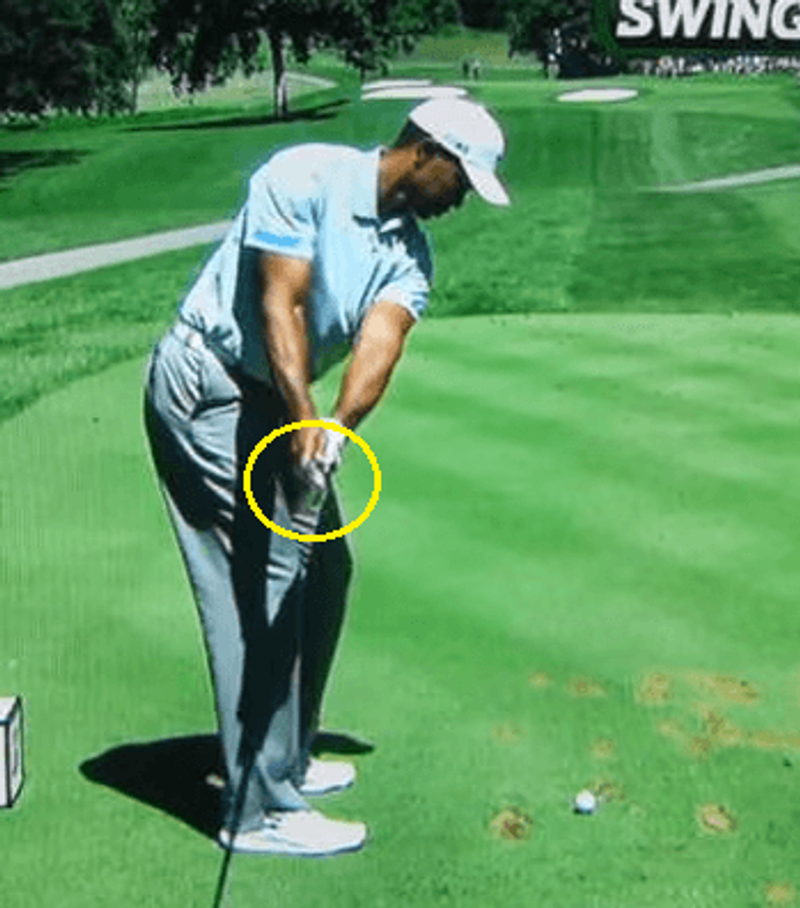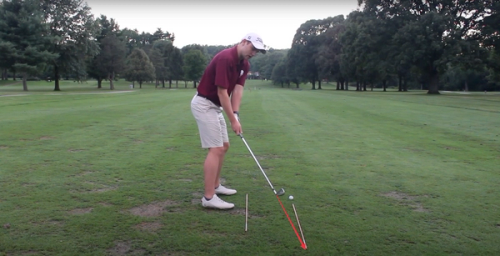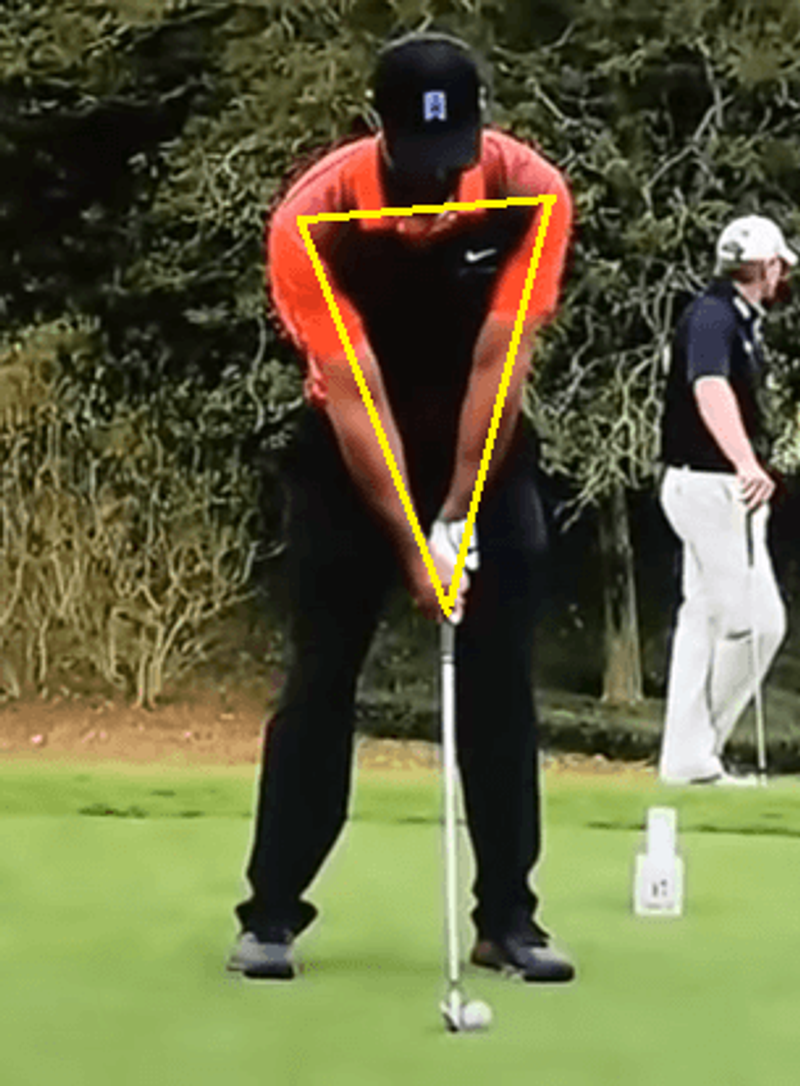In the previous post, I discussed how important the trigger is to properly executing the golf swing. Almost equally important is the first portion of the backswing, which is the takeaway. This is important because during this period of the swing, the golf club goes from an inert object to one which follows the physics of angular motion. In other words, when the takeaway portion of the backswing is complete, the club will be essentially "locked in" to the path of motion which it starts on. This is because as the club-head gains momentum, it resists directional change as stated by Newton's first law of motion. Although the later parts of the backswing are important to analyze, they are largely a result of what you do during the takeaway.
So what is the takeaway?
I, and several other instructional texts define the takeaway as the period of motion between the start of the backswing and when the club shaft becomes parallel to the ground (P1-P2).
It may seem like a rather short movement, but there are a plethora of things that can go wrong here thanks to the anatomical makeup of the body, which requires several independently moving parts to come together into a unified motion. I will do my best to cover as many questions as you may have about this portion of the swing below.
Proper Takeaway
Our first business to attend to is finding out what a proper takeaway looks like. Since it is only a short movement, we can check it by using one camera view. With a properly positioned DTL camera view, at the end of the takeaway, the clubshaft should be parallel to the ground and the target line (parallel left of the straight line base of the inclined plane) at the same time. It looks like so:

Notice how the club-shaft has disappeared from view because it is parallel to the ground and parallel left of the target line.
This is easy to check, but often difficult to achieve, so let's examine what specific movements are happening to get to this position.
Homer Kelley's "Flying Wedges"
In The Golfing Machine, Homer Kelley explains a critical concept called the "flying wedges," which makes the takeaway much easier to understand. The "flying wedges" is simply a way of explaining that at ALL points in the golf swing (except the address position and very final finish position), the left wrist should only move in a vertical plane of motion, and the right wrist should only move in a horizontal plane of motion. To make sense of this, we must first understand all the individual movements that our wrists and forearms can make during the swing, which Homer Kelley called "educating the hands." Click the following link for a picture glossary and in depth explanation of this idea. I will be referencing this concept throughout the remainder of this post and others in the instructional series.
Left Arm vs. Right Arm vs. One Piece Takeaway
The first thing that we need to cover regarding the takeaway is which muscles lift the club back to the end position of the takeaway? By experimentation, you might realize that the club can be taken back with predominantly the left arm, right arm, or equally both arms.
Left Arm Takeaway
I wanted to start with the left arm controlled takeaway because I believe it to be the least effective way to take the club back. This is mainly because being the non-dominant arm, it is often difficult to guide the club on a correct path. In addition, it is working against physics, as it is more of a pushing force than pulling force. To understand this, imagine a truck with a trailer on the back. It is much easier to guide the trailer when the truck is moving forward, because it is pulled in line with the truck's path of motion. Backing up is not so easy though. If you've ever tried to go in reverse with a trailer attached to the back of your vehicle, you know just how difficult this maneuver is.
If this explanation doesn't convince you how difficult a left arm takeaway is, I suggest picking up a club and trying to chip/pitch a few golf balls with only your left hand. You will notice how difficult it is to direct the club back on a proper plane of motion.
Sure, a golfer can successfully play with a left arm takeaway, but I personally do not recommend it.
Right Arm Takeaway
A much more preferable way to take the club back is by using the right arm as a means of "lifting" the club via the right arm, and letting the left arm come for the ride. Explained above, this incorporates more of a "pulling" force on the club, which allows it to remain in line with the path of motion that the hands take.
General Overview of Right Arm Takeaway
The right arm takeaway is largely controlled by contracting the right arm bicep. Like any proper takeaway, the club traces the "optimal plane," and preferably ends in the position shown in the picture above. The defining characteristic of this takeaway is the fact that the right arm is doing most of the work, and to most, will feel as if they are swinging the club with only the right arm. Of course, this isn't the case, but is the intended "feel."
Wrist Cock (radial deviation) of Right Arm Takeaway
When performing the right arm takeaway, the club is essentially being lifted up and in, which naturally leads to a gradual cocking of the left wrist. Those who prefer to delay the wrist cock during the backswing, and who like the feeling of a "wide" takeaway might prefer a one piece takeaway, which will be discussed next in this post.
Cautions of the Right Arm Takeaway
Although this motion is simple, there are a few warnings that I would like to give. Firstly, it is quite common when using the right arm takeaway to forget to rotate the shoulders. When this happens, the left shoulder will stay in its address position, while the right arm will pull the left arm across the chest wall. I will be talking about this fault more in the later portions of the backswing, but make sure that during this initial part of the backswing, the right arm is not only lifting and pulling the left arm, but also the left shoulder. I like to imagine that at address, there is a fixed joint under my armpit, which locks the left shoulder and the chest together. The right arm then lifts and pulls this entire joint along with it.
This particular fault is dangerous because during the takeaway, it is often difficult to recognize when it is happening. Only when the club reaches the later parts of the swing does the golfer begin to notice the fault.
Another fault that golfers make with the right arm takeaway is moving the right arm in the wrong path, or in other words "off plane." To fix this, I recommend my laser takeaway drill:

The laser takeaway drill is the simplest and easiest way to learn what an "on-plane" takeaway feels like.
One-Piece Takeaway
The one piece takeaway is arguably the most common takeaway method, and is quite relevant on the PGA Tour. When watching golf on t.v., you might hear a commentator mention how "wide" the player's takeaway is. They will go on to explain how this wide takeaway leads to power (which is not entirely true), and how it is a "textbook" movement. What they are referring to is the one piece takeaway. Bio-mechanically, there is no clear advantage of using the one-piece takeaway vs. the right arm takeaway.
General Overview of the One Piece Takeaway
The one piece takeaway can be defined by the triangle formed between the shoulders, left arm, and right arm at address. Instead of using the right arm to pull the left arm/shoulder, the entire triangle is moving as one unit, and the golfer should feel an equal amount of force in both hands while taking the club back.

Wrist Cock (radial deviation) of the One Piece Takeaway
Since the one piece takeaway isn't being "lifted" by the right arm, the club will travel lower to the ground during the backswing, and with less radial deviation of the left wrist. At the end of the takeaway (club shaft parallel to ground), the left wrist will have essentially zero radial deviation.
Cautions of One Piece Takeaway
Since this takeaway is largely directed by the turning of the shoulders, it is critically important that the shoulders turn in the correct manner. Many times, a golfer using this takeaway will turn too steeply with the shoulders, causing a closed clubface during the takeaway. This steep shoulder turn often leads to a reverse pivot later in the swing, but I will refrain from skipping ahead at this point. If the golfer has too shallow of a shoulder turn, the clubface will be slightly open, and will tend to move behind the golfer (under the optimal plane). To practice the correct shoulder turn during the takeaway, I once again recommend using a laser pointer to trace an alignment stick which represents the base of the inclined plane. The shoulders should turn roughly perpendicular to the spine at address.
Another caution that I must make about the one piece takeaway is the tendency to ulnar deviate the left wrist during the takeaway. Often times when an instructor tells a student to delay the wrist cock, the student will go in the opposite direction and experience ulnar deviation of the left wrist. Although this isn't technically a "mistake" during the backswing, it is important that a golfer doing it is aware that he/she is doing it. If the golfer mistakenly does this, it can cause the "triangle" and the club to be thrown out of sequence.
General Cautions of all takeaway motions
Regardless of which takeaway you choose to use, there are some general cautions that I must mention. While talking about the topics hereafter, I am assuming that the golfer has read my post about the setup, posture, and alignment, and is executing a proper setup to the golf ball.
Swaying
It is fairly common advice to "shift the weight back" during the golf swing, which is not wrong, but is often misinterpreted. More often than not, this swaying happens immediately during the takeaway, and is characterized by the head moving laterally to the right, and the weight moving almost entirely to the right foot. This not only causes the club to move off plane, but also shifts the entire center of the golf swing to the right. No matter what the golfer does after this, he/she must shift this center back to the left at some point, which is a terribly difficult thing to execute while simultaneously performing other complicated movements in the swing.
On the contrary, when someone like me on the internet warns the golfer to avoid swaying back to the right foot, he/she will compensate by going the opposite way! In an attempt to stay centered, the golfer will keep the head centered during the takeaway, but will shift the weight on to the left foot by bending the left knee:

This doesn't shift the center of the swing, but by bending the left knee, the golfer has lowered the low point of the swing, and must stand back up at some point. This is also difficult to recover from.
To avoid both of these problems during the takeaway, make sure that the head stays stationary not only in the lateral direction, but also the vertical direction. When this is executed correctly, at the end of the takeaway, it should feel as if the weight has barely shifted at all, slightly favoring the right side due to the weight of the club and arms being on that side of the body. Think of the right leg as a "post" that essentially remains inert, and the left leg as a "hinge," which can bend at the knee slightly (not drastically) to allow the head to remain centered.
Off Plane Movements
I have mentioned this in both the section on the right arm takeaway as well as the one piece takeaway, but it is worth repeating. Regardless of the type of takeaway, the club should trace the optimal plane.
A great way to practice getting the takeaway on plane is by hitting 5 yard chip shots with a wedge, ending the backswing when the club is parallel to the ground, and following through until the club becomes parallel to the ground. If you can't properly execute this simple little swing, then I'm not sure how you plan on making a full swing!
Recap
This entire post has been dedicated to an extremely small portion of the golf swing, but an important one at that! In this post, we have covered some important concepts. To review:
- The takeaway is important because at the end of the takeaway, the club has gained a significant amount of momentum. Due to this momentum, it is extremely difficult to alter the path that the club travels on later in the swing. This is why we must be so adamant about getting the club tracing the optimal plane during the takeaway.
- There are two recommended types of takeaways, both of which are effective in executing a golf swing.
- During the takeaway, remember to keep the head centered to avoid swaying. Right leg is a post, left leg is a hinge.
In the next section, I will be discussing what happens between the end of the takeaway and the top of the backswing.
